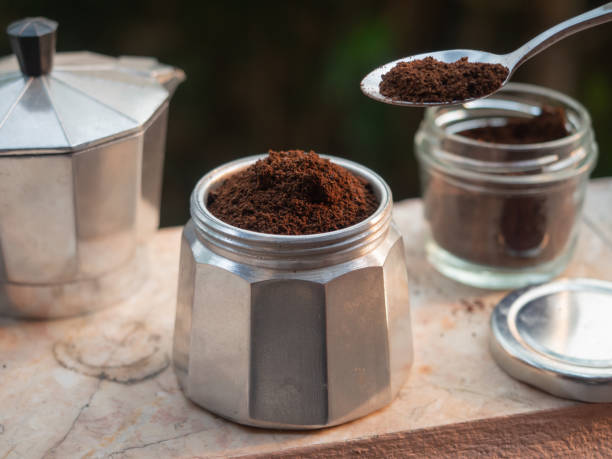Crafting the perfect cup of coffee is an art and a science, one that begins with understanding the crucial ratio of coffee grounds to water. In our comprehensive guide, “How Much Coffee Grounds Per Cup,” we delve deep into the heart of brewing excellence. With expertise grounded in years of research and practice, we’re here to demystify the process, ensuring every reader can achieve barista-level results in the comfort of their own home.
Why does this ratio matter so much? The amount of coffee grounds you use directly influences the strength, flavor, and aroma of your brew. Too little, and you risk a watery, underwhelming cup; too much, and you might find yourself facing a bitter, overpowering concoction. Our article doesn’t just offer a one-size-fits-all answer; it explores the nuances, allowing for personal preference and variations in coffee type, grind size, and brewing method.
But we don’t stop at mere measurements. We empower you with the knowledge to experiment confidently, understanding the why behind the how. From the science of extraction to the impact of grind size and water quality, we cover it all. Whether you’re a seasoned coffee aficionado or a curious newcomer eager to elevate your morning ritual, our guide is designed to intrigue, educate, and inspire.
Join us as we embark on a journey through the world of coffee. Discover the secrets to unlocking the full potential of your beans, and transform your daily brew into an extraordinary sensory experience. “How Much Coffee Grounds Per Cup” isn’t just an article; it’s your first step towards mastering the art of coffee making. Let’s dive in and explore together.
Finding Your Perfect Cup

- Personal preference reigns supreme: There’s no one-size-fits-all answer, explore and experiment to discover your ideal taste.
- Mastering the basics: Focus on key elements like grind size, water temperature, and brewing time for consistent results.
Brewing Methods & Ratios
Drip
- Ratio: 1-2 tablespoons of grounds per 6 ounces of water (Golden Ratio).
- Grind: Medium-fine.
- Tips:
- Adjust ratio based on taste, consider pre-infusion for richer flavor.
- Grind size should be similar to granulated sugar.
- Water temperature 195-205°F.
French Press
- Ratio: 1-1.5 tablespoons of grounds per 8 oz of water.
- Grind: Coarse.
- Tips:
- Use a coarse grind to avoid bitterness, steep for 4 minutes for full flavor.
- Don’t leave grounds in press for too long after pressing.
Espresso
- Ratio: 7-9 grams of grounds per 1 oz of water.
- Grind: Fine.
- Tips:
- Use a dedicated espresso machine and grinder for optimal results.
- Aim for an extraction time of 25-30 seconds.
- Tamp grounds with 30 lbs of pressure.
Cold Brew
- Ratio: 1 cup of grounds per 4 cups of water.
- Grind: Coarse.
- Tips:
- Steep for 12-24 hours for smooth, concentrated coffee.
- Dilute concentrate or use less grounds for lighter flavor.
Beyond the Basics
- Grind size matters: Different methods require specific grind sizes for optimal extraction.
- Water temperature: Aim for 195-205°F for most brewing methods, adjust for cold brew.
- Brewing time: Experiment within recommended ranges to find your preferred strength and flavor.
| Method | Grind Size | Water Temp | Brew Time |
| Drip | Medium-Fine | 195-205°F | 4-6 minutes |
| French Press | Coarse | 200-205°F | 4 minutes |
| Espresso | Fine | 198-205°F | 25-30 seconds |
| Cold Brew | Coarse | Room Temp | 12-24 hours |
Troubleshooting When Making Coffee
If you have issues with coffee flavor, try these tips:
- Weak coffee:
- Use more grounds, finer grind, or longer brew time. This extracts more flavor from the coffee.
- Check water temperature, ensure it’s 195-205°F. Hotter water extracts better.
- For drip, try pre-infusion to ensure even saturation.
- Bitter coffee:
- Use less grounds, coarser grind, or shorter brew time. This avoids over-extraction bitterness.
- Use demineralized water to avoid bitterness from minerals.
- For drip, pour water slowly to prevent aggressive extraction.
- Sour coffee:
- Use freshly roasted coffee, finer grind, or shorter brew time. This reduces oxidation acidity.
- Note shelf life after opening bag. Old coffee oxidizes faster.
- Clean equipment regularly to remove old tastes and oils.
Note When Making Coffee

To consistently brew a great tasting cup:
- Use freshly roasted coffee, within 2 weeks of roast date. Fresher coffee has more vibrant flavor.
- Use filtered water to remove minerals affecting taste. Neutral pH water is ideal.
- Store leftover coffee in a thermos to maintain freshness. Limit coffee’s exposure to oxygen.
- Sip slowly, savoring aromas before drinking. This enhances the experience.
- Take note of factors influencing taste to find your perfect preferences.
Best of luck on your journey to discover and enjoy coffee you love.
Conclusion
Finding the ideal coffee to water ratio for your preferred brewing method is a fun journey of exploration and experimentation. With fresh beans and these tips in hand, you’ll be brewing amazing coffee in no time. So get creative, calibrate to your tastebuds, and enjoy the pursuit of coffee perfection.
